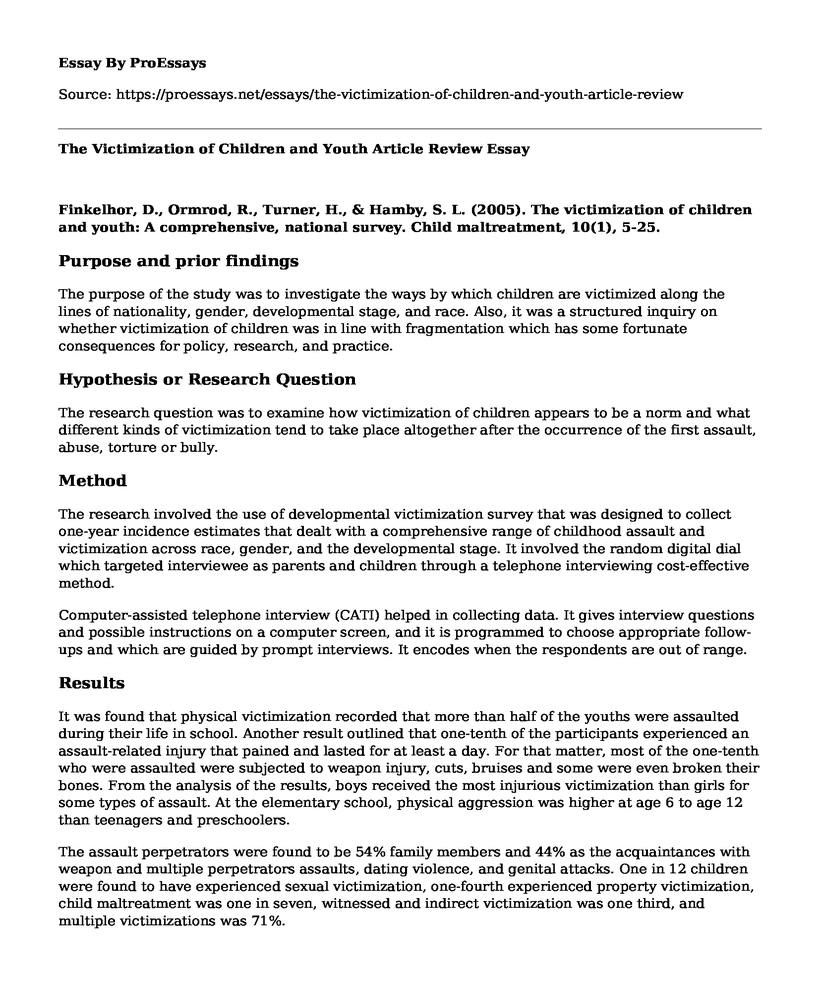Finkelhor, D., Ormrod, R., Turner, H., & Hamby, S. L. (2005). The victimization of children and youth: A comprehensive, national survey. Child maltreatment, 10(1), 5-25.
Purpose and prior findings
The purpose of the study was to investigate the ways by which children are victimized along the lines of nationality, gender, developmental stage, and race. Also, it was a structured inquiry on whether victimization of children was in line with fragmentation which has some fortunate consequences for policy, research, and practice.
Hypothesis or Research Question
The research question was to examine how victimization of children appears to be a norm and what different kinds of victimization tend to take place altogether after the occurrence of the first assault, abuse, torture or bully.
Method
The research involved the use of developmental victimization survey that was designed to collect one-year incidence estimates that dealt with a comprehensive range of childhood assault and victimization across race, gender, and the developmental stage. It involved the random digital dial which targeted interviewee as parents and children through a telephone interviewing cost-effective method.
Computer-assisted telephone interview (CATI) helped in collecting data. It gives interview questions and possible instructions on a computer screen, and it is programmed to choose appropriate follow-ups and which are guided by prompt interviews. It encodes when the respondents are out of range.
Results
It was found that physical victimization recorded that more than half of the youths were assaulted during their life in school. Another result outlined that one-tenth of the participants experienced an assault-related injury that pained and lasted for at least a day. For that matter, most of the one-tenth who were assaulted were subjected to weapon injury, cuts, bruises and some were even broken their bones. From the analysis of the results, boys received the most injurious victimization than girls for some types of assault. At the elementary school, physical aggression was higher at age 6 to age 12 than teenagers and preschoolers.
The assault perpetrators were found to be 54% family members and 44% as the acquaintances with weapon and multiple perpetrators assaults, dating violence, and genital attacks. One in 12 children were found to have experienced sexual victimization, one-fourth experienced property victimization, child maltreatment was one in seven, witnessed and indirect victimization was one third, and multiple victimizations was 71%.Discussion/Conclusions
Young children are pervasively exposed to violence, maltreatment, violence and all other forms of victimization as a way of life or part of the lifestyle. It was found out that at 6-12 years, the children are usually attached to a way of life that their parents have taught them thus tend to reflect it by assaulting their fellows in line with their color, gender, race and social status. Since for the teenagers less victimization occurs, it shows that teenagers tend to start thinking for themselves thus view victimization in a different angle.
Critical Review/Notes
Sibling victimization also spurs ultimate revenge on other children among the 6-12-year old children. Parents also tend to encourage the behavior of children assaulting their fellows. Bad habits during childhood result in more victimization.
Cite this page
The Victimization of Children and Youth Article Review. (2022, Mar 29). Retrieved from https://proessays.net/essays/the-victimization-of-children-and-youth-article-review
If you are the original author of this essay and no longer wish to have it published on the ProEssays website, please click below to request its removal:
- How the Private Sector Can Help Tackle the Refugee Crisis Essay
- Essay Sample on Shining Path
- The Birth of Palestinian Refugee Crisis Analysis
- Gender Issues in Fine Arts and Fashion Design Essay
- Research Paper on U.S. Gun Export & Gun Violence: A Growing Threat
- Essay Example on Drug Abuse & Crime: United States Crisis
- Essay Example on Sex Offender Management: Prevention and Intervention Techniques







